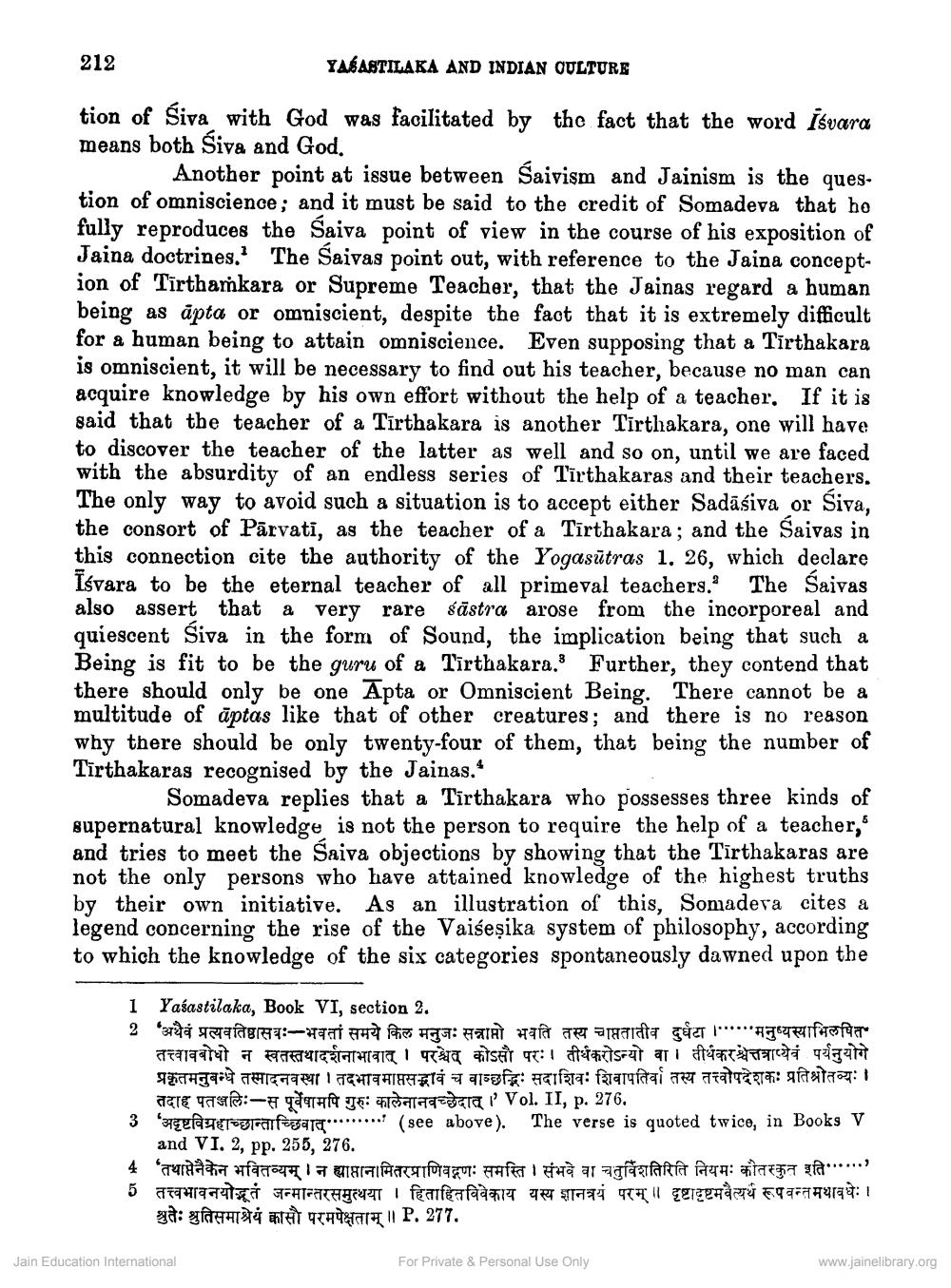________________
212
YASASTILAKA AND INDIAN CULTURE
tion of Siva with God was facilitated by the fact that the word Isvara means both Śiva and God.
Another point at issue between Saivism and Jainism is the ques. tion of omniscience; and it must be said to the credit of Somadeva that ho fully reproduces the Saiva point of view in the course of his exposition of Jaina doctrines.' The Saivas point out, with reference to the Jaina conception of Tirthamkara or Supreme Teacher, that the Jainas regard a human being as apta or omniscient, despite the fact that it is extremely difficult for a human being to attain omniscience. Even supposing that a Tirthakara is omniscient, it will be necessary to find out his teacher, because no man can acquire knowledge by his own effort without the help of a teacher. If it is said that the teacher of a Tirthakara is another Tirthakara, one will have to discover the teacher of the latter as well and so on, until we are faced with the absurdity of an endless series of Tirthakaras and their teachers. The only way to avoid such a situation is to accept either Sadāśiva or Śiva, the consort of Pārvati, as the teacher of a Tirthakara; and the Saivas in this connection cite the authority of the Yogasūtras 1, 26, which declare Isvara to be the eternal teacher of all primeval teachers. The Saivas also assert that a very rare sästra arose from the incorporeal and quiescent Siva in the form of Sound, the implication being that such a Being is fit to be the guru of a Tīrthakara. Further, they contend that there should only be one Apta or Omniscient Being. There cannot be a multitude of āptas like that of other creatures; and there is no reason why there should be only twenty-four of them, that being the number of Tirthakaras recognised by the Jainas.
Somadeva replies that a Tirthakara who possesses three kinds of supernatural knowledge is not the person to require the help of a teacher, and tries to meet the Saiva objections by showing that the Tirthakaras are not the only persons who have attained knowledge of the highest truths by their own initiative. As an illustration of this, Somadera cites a legend concerning the rise of the Vaiseșika system of philosophy, according to which the knowledge of the six categories spontaneously dawned upon the
1 Yaśastilaka, Book VI, section 2. 2 'अथैवं प्रत्यवतिष्ठासवः-भवतां समये किल मनुजः सन्नातो भवति तस्य चाप्ततातीव दुर्घटा ।..."मनुष्यस्याभिलषित
तत्त्वावबोधो न स्वतस्तथादर्शनाभावात् । परश्चत् कोऽसौ परः। तीर्थकरोऽन्यो वा। तीर्थकर श्चेत्तत्राप्येवं पर्यनुयोगे प्रकृतमनुबन्धे तस्मादनवस्था । तदभावमाप्तसद्भावं च वाग्छद्भिः सदाशिवः शिवापतिर्वा तस्य तत्त्वोपदेशकः प्रतिश्रोतव्यः ।
aare 47:- defa yk: dastatasarai Vol. II, p. 276. 3 healografegar........ (see above). The verse is quoted twice, in Books V
and VI. 2, pp. 255, 276. 4 'तथाप्तेनैकेन भवितव्यम् । न ह्याप्तानामितरप्राणिवद्गणः समस्ति । संभवे वा चतुर्विशतिरिति नियमः कौतस्कुत इति""""" 5 तत्त्वभावनयोद्भूतं जन्मान्तरसमुत्थया । हिताहित विवेकाय यस्य ज्ञानत्रयं परम् ॥ दृष्टादृष्टमवैत्यर्थ रूपवन्तमथावधेः ।
ga: giá Hệ điềI THÀNH || P. 277.
Jain Education International
For Private & Personal Use Only
www.jainelibrary.org




